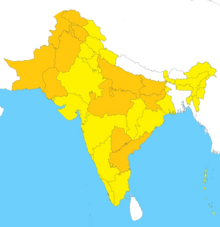
Back Bahsa Urdu ACE Oerdoe Afrikaans ኡርዱ Amharic Idioma urdú AN Urdusc sprǣc ANG उर्दू भाषा ANP اللغة الأردية Arabic ܠܫܢܐ ܕܐܘܪܕܘ ARC ؤردو ARY اوردو ARZ
| Urdu | |
|---|---|
| Lashkari (لِشٍّکری) | |
| اُرْدُو | |
 Urdu in Nastaliq script | |
| Pronunciation | [ˈʊrduː] ( |
| Native to | India and Pakistan |
| Region | South Asia |
Native speakers | 68.62 million (2021) Total: 230 million (2021)[1] |
Early forms | |
| Dialects | |
| |
| |
| Official status | |
Official language in | (national)
|
Recognised minority language in | |
| Regulated by | National Language Promotion Department (Pakistan) National Council for Promotion of Urdu Language (India) |
| Language codes | |
| ISO 639-1 | ur |
| ISO 639-2 | urd |
| ISO 639-3 | urd |
| Glottolog | urdu1245 |
| Linguasphere | 59-AAF-q |
 Areas in India and Pakistan where Urdu is either official or co-official
Areas where Urdu is neither official nor co-official | |
Urdu, also known as Lashkari,[8] or the Lashkari language (لِشْکری زَبَانِ)[9] is the national language of Pakistan and a recognized regional dialect in India. Urdu is an Indo-Aryan language, which means that it came from Proto-Indo-Aryan, a language that was spoken northeast of the Caspian Sea in the second millennium BCE.[10]
Most people in Pakistan speak it as a lingua franca. There are parts of India that speak it, such as Delhi, Bihar, and Uttar Pradesh, for example. Despite a few differences, the words in Hindi are very similar to Urdu. The way it is written, is different from how Hindi is written. People who speak Hindi and Urdu may be able to able to understand or express the meaning of one of these two scripts in any order.
- ↑ "What are the top 200 most spoken languages?". Ethnologue. 3 October 2018. Retrieved 2021-02-26.
- ↑ Hindustani (2005). Keith Brown (ed.). Encyclopedia of Language and Linguistics (2nd ed.). Elsevier. ISBN 0-08-044299-4.
- ↑ Gaurav Takkar. "Short Term Programmes". punarbhava.in. Archived from the original on 15 November 2016. Retrieved 29 March 2015.
- ↑ "Indo-Pakistani Sign Language", Encyclopedia of Language and Linguistics
- ↑ "Urdu is Telangana's second official language". The Indian Express. 16 November 2017. Retrieved 27 February 2018.
- ↑ "Urdu is second official language in Telangana as state passes Bill". The News Minute. 17 November 2017. Retrieved 27 February 2018.
- ↑ "Constitution of the Republic of South Africa, 1996 - Chapter 1: Founding Provisions". www.gov.za. Retrieved 6 December 2014.
- ↑ Aijazuddin Ahmad (2009). Geography of the South Asian Subcontinent: a critical approach. Concept Publishing Company. pp. 120–. ISBN 978-81-8069-568-1.
The very word Urdu came into being as the original Lashkari dialect, in other words, the language of the army.
- ↑ "Lahore During the Ghaznavid Period" (PDF). Kanwal Khalid, PhD Associate Professor, College of Art and Design University of the Punjab, Lahore.
- ↑ Trautmann, Thomas, and Yoda Press. "Indo-European topics."